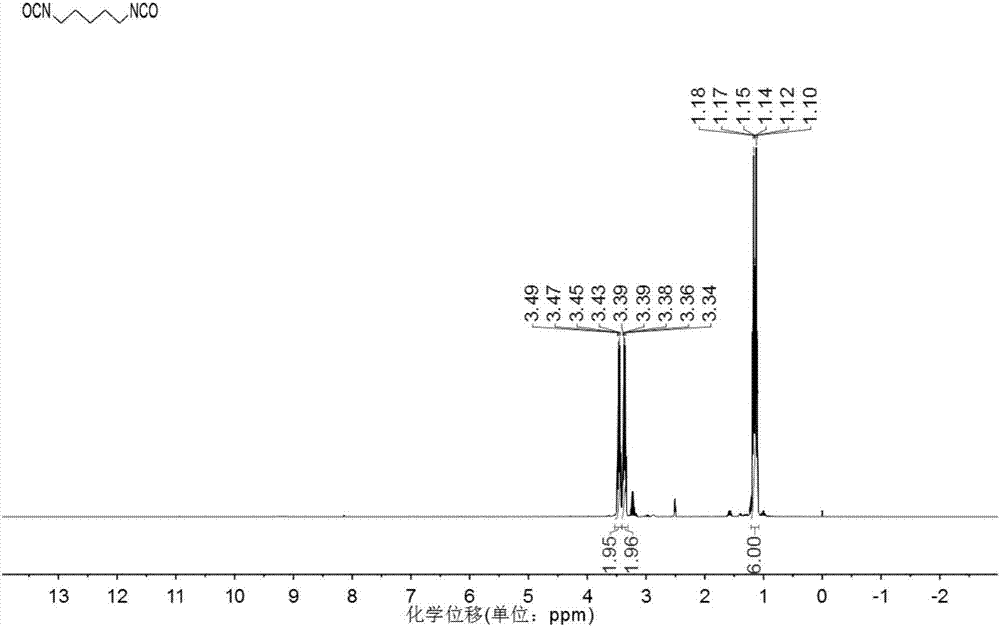Method for synthesizing biobased 1,5-pentadiisocyanate
A technology of pentamethylene diisocyanate and synthesis method, which is applied in the field of synthetic bio-based 1, can solve the problems of long time, high energy consumption of reaction, use of highly toxic substances, etc., and achieve the effect of high conversion rate, simple post-treatment, and mild reaction conditions
- Summary
- Abstract
- Description
- Claims
- Application Information
AI Technical Summary
Problems solved by technology
Method used
Image
Examples
Embodiment 1
[0026] A) 1,5-pentanediamine (12.24g) and triethylamine (82.8mL) were dissolved in 200mL of chloroform and pre-mixed at 0°C to obtain component A of the mixed material; triphosgene (35.5g) was pre-dissolved in 150mL In chloroform, stir and dissolve evenly at 0°C under a nitrogen atmosphere to form component B; component A is added dropwise to material B at 0°C using a syringe pump at a flow rate of 1.0mL / min, stir and mix quickly, and maintain the reaction for 5h , the tail gas generated in the process is absorbed by aqueous sodium hydroxide solution. After no obvious tail gas is generated, chloroform and triethylamine are removed under reduced pressure after filtering to remove organic salts, and the rear distillation obtains 16 g of colorless and transparent product 1,5-pentanediisocyanate. The rate is 86.5%.
Embodiment 2
[0028] A) 1,5-pentanediamine (12.24g) and triethylamine (82.8mL) were dissolved in 200mL of chloroform to obtain component A of the mixed material; triphosgene (35.5g) was pre-dissolved in 300mL of chloroform, and Stir and dissolve evenly at 0°C in the atmosphere to form component B; group A uses a syringe pump to add dropwise to material B at 0°C at a flow rate of 0.5mL / min, stirs quickly, stirs at 10°C for 6h, and uses three The ethanol solution of ethylamine was absorbed, the organic salt was removed by suction filtration, chloroform and triethylamine were removed by rotary evaporation, and 16.5 g of colorless and transparent product 1,5-pentanediisocyanate was obtained by rotary evaporation with a yield of 89%.
Embodiment 3
[0030] A) 1,5-pentanediamine (61.2g) and triethylamine (400mL) were dissolved in 1L of chloroform to obtain component A of the mixed material; triphosgene (177.5g) was dissolved in 1.5L of chloroform in advance, and dissolved in nitrogen Stir and dissolve evenly at 0°C in the atmosphere to form B component; use a syringe pump to add dropwise to material B at a flow rate of 1.5mL / min. During the process, keep the temperature at about 5°C, stir mechanically for 6 hours, and filter under reduced pressure to remove organic salts , chloroform and triethylamine were removed by rotary evaporation, and post-distillation gave 80 g of colorless and transparent product 1,5-pentanediisocyanate with a yield of 87%. After the triethylamine hydrochloride obtained by filtering the system is mixed with the triethylamine hydrochloride obtained in the tail gas absorption process, the pH is adjusted by caustic soda, and then layered and dried to obtain triethylamine, which can be used in the next ...
PUM
 Login to View More
Login to View More Abstract
Description
Claims
Application Information
 Login to View More
Login to View More - R&D
- Intellectual Property
- Life Sciences
- Materials
- Tech Scout
- Unparalleled Data Quality
- Higher Quality Content
- 60% Fewer Hallucinations
Browse by: Latest US Patents, China's latest patents, Technical Efficacy Thesaurus, Application Domain, Technology Topic, Popular Technical Reports.
© 2025 PatSnap. All rights reserved.Legal|Privacy policy|Modern Slavery Act Transparency Statement|Sitemap|About US| Contact US: help@patsnap.com

